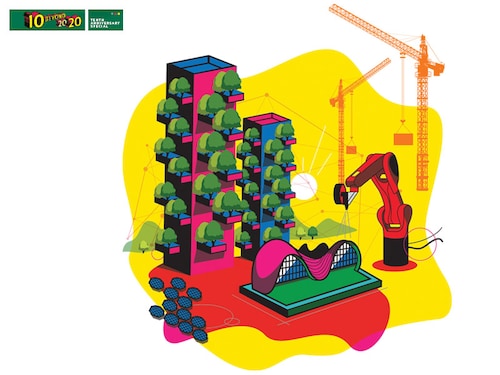Future of buildings: Putting the tech in architecture
Data analytics combined with responsible design will create better experiences in our built environment



Illustration: Chaitanya Dinesh Surpur [br]The Tewaris are betting big on technology. The Delhi-based architect couple, Gautam and Tithi, has scaled down their design practice and poured their personal funds into creating a virtual reality (VR) startup, SmartVizX, which builds fully immersive technology solutions for the building industry, bringing together all stakeholders in the design process to collaborate. Called Trezi, their product enables a one-click VR walkthrough of one or more 3D design models, and the reviewing and editing of designs early in the project’s life cycle. It empowers the client as partners in the design process.
Raising $2 million so far (in pre-series A funding from YourNest Venture Capital and the Indian Angel Network), the company has on-boarded some of the largest architectural firms like Gensler, Venkataramanan Associates, Raheja Universal and real estate firms like CBRE and Cushman & Wakefield.
“We are at the cusp of a very important technological shift in the whole world. Spatial computing will become an intrinsic part of architecture, where there will be a lot of data mining of what works for the end user. We will design according to that data. Your future designs are going to be ruled a lot by the feedback loop,” says Tithi, founder and MD, SmartVizX.
However, there are challenges. “The real estate and architecture sectors in India are archaic, using obsolete design methods and outdated techniques. Real estate is the second last sector when it comes to technology adoption,” says Tithi Tewari.
According to the Diffusion of Innovation Theory, says Sushant Verma, architect and design technologist, who is the founding partner and design head at rat(LAB), a Delhi-based design consultancy that carries out research in architecture and technology, every technology goes through five phases to permeate the population: The first 2.5 percent, who are the innovators, followed by 13.5 of early adopters, 34 percent of early majority, 34 percent of the late majority, and finally the 16 percent of laggards. Architecture technology, he adds, has permeated only to the first 2.5 percent.
“Most architects are not willing to use technology as they think it’s going to take away the human aspect in design and architecture,” says Verma.
Verma and his team are adopting a ground-up approach to change the industry. He has been conducting workshops on computation design for architecture students, which run parallel to the formal education system.
Using computation, rat(LAB) has designed a facade and a roof system that automatically changes shape, using heat from the sun. It controls the amount of heat and light inside the building without using any electricity.
Talking of the future of architecture, Verma is confident that design technologies are bound to get smarter and more efficient, with a fair involvement of humans in the tech-embedded ecosystem. Computational design, with its software-driven subsets of parametric design, evolutionary design, generative design and algorithmic design, will be well supported by hardware-driven technologies such as robotics, machine learning and digital fabrication systems.
Echoing these sentiments, London-based Shajay Bhooshan, senior associate at Zaha Hadid Architects and co-founder of Zaha Hadid Architects Computation and Design Group, says, “In the near future, computational technologies, including AI, will be used to augment the intelligence of human designers. Such intelligence augmentation will enable designers to construct hypotheses, evaluate their implications on myriad social and physical aspects of the built environment, and choose appropriate solutions.”
He adds, “Our ability to forecast or predict implications will make wide-ranging changes in the economics of building and social acceptance of design. The most important change will be designing for change and adaptation, as opposed to design for static permanence.”
So forms in the future are likely to be more fluid. “It will address sustainability from first principles as opposed to tick-box exercises. Being socially adaptive, it will address social issues with as much scientific rigour as physical aspects of the built environment, and will have a wide spectrum of outcomes—from advanced technological demonstrators to co-existence with ancient building traditions. It will be not only for the unique, one-off buildings, but also for mass-consumer markets, and social housing,” says Bhooshan.
Chandigarh-based architect Noor Dasmesh Singh of Noor Architects Consultants feels that solutions are many, once this road towards technology and digital fabrication is taken. By deploying technologies like mass customisation, BIM (building information modelling), parametric design, rapid prototyping, and digital fabrication, one can come close to satiating the demands of a rapidly urbanised and developing world.
“By the end of the century, most of the world’s population will live in cities. These city clusters will expand their physical boundaries—big, small, or even contiguous, woven into an urbanised world,” says Singh.
Work spaces will become collaborative and interactive. The future is going to be about cross-fertilisation of ideas. “Whatever you create for millennials has to facilitate that creativity, that thought process. Large organisations like Accenture and Amazon don’t want to get into the hassle of managing real estate, the hassle of leasing property. They are approaching companies like WeWork, CoWrks. So the whole business model is changing and it’s happening very rapidly,” says Tithi Tewari.
“Along with co-working, co-living is also coming. The new buildings that will be designed will have offices and homes together. Millennials would want to be within one kilometre of their workplace, and wouldn’t want to spend all the time on the road. This is going to be the future. We can’t stop it. We just have to have our response around it. We will be designing for people with a very different outlook about their lives. We will be designing buildings that will be multipurpose, that can be reconfigured, where a hotel can become an office and a home and back to a hotel. With robotic walls and hot desking, spaces will become transformable,” adds Tithi Tewari.
The future of cities is digital, and environmentally and socially friendly, thereby changing the way we live, work and play. ‘Smart cities’ can serve as a foundation for a positive change, sustainable growth and innovation. Areas such as health care, transportation and education would potentially get more responsive, making them networked and part of the Internet of things (IoT).
“A tool like the urban data modeller uses various parameters scientifically, like a city’s bylaws, building height, climatic data, wind direction, road network, and any data that can be quantified, and we can use that to design a city. A city designed using these parameters is a smart city. Designs like these can transform the way we live and work,” says Verma.
Speaking of policy, Amit Sarma, principal at Spatial Analytics, has been concerned about the way in which cities are planned today. “Architects and urban designers are looking at individual buildings. We can be greener as a neighbourhood than an individual building. When it comes to technology, we have to use it in the service of the environment, economy and society. We can’t use technology as an end in itself. Unless we can live within certain limits of water, electricity, emissions, and biodiversity our cities are not going to survive, our countries are not going to survive.”
Sarma is trying to come up with an Alternative Masterplan Framework that could be applicable to every city in the world. “The very fundamentals of the challenges we face are limited supplies of resources. Our earth can supply only a certain amount of fresh water and can absorb only a certain amount of sewage. So, we have to live within this framework. We need to start looking at what the planet has to offer, what is each country’s share, therefore, planning should be about, ‘How do we distribute a country’s share of fresh water, minerals, electricity etc., and its ability to pollute the atmosphere?’”
As the population in countries like India rises at a staggering rate, resources become scarcer. Therefore, an efficient and conscious use of available resources becomes imminent. “At a city level, rather than defining what function a particular site in the city needs to have and how much volume that site will occupy, planning needs to start looking at what the overall resources available to the city are, what is the capacity of water, gas, electricity and sewage. How much parking do we need?” says Sarma.
To distribute these resources, Sarma has come up with a resource performance index. “Instead of giving FSI, and restrictions on height and land use for each plot, we give a resource consumption limit to a plot. On your plot, you have 100 units of electricity. If you want to use it for a high consumption bungalow, with a heated swimming pool, you can build perhaps a single floor. However, if you use it to build a low-consumption, possibly low-income green building, you may be able to build eight floors. The ultimate volume of the building is, therefore, a result of efficient usage of resources. This suggests that entrepreneurship of the future can be directed to maximise the social and economic value of scarce ecological resources. There is immense value to be gained from putting capitalism to the service of the planet,” says Sarma.
First Published: May 17, 2019, 10:58
Subscribe Now